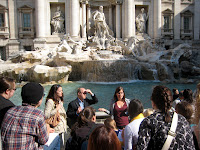



This was the week of Bernini. But not only Bernini. We began our eighth week with a trip to St. Peter's. We donned our headsets and braved the crowds. We first considered the impact of Bernini's Baldacchino, realizing that his evocation of ephemeral structures serves still to frame the cathedra of St. Peter and to anchor the viewer in the vast space of the basilica. We proceeded to the crossing of the church where Professor (Estelle) Lingo led us in a discussion of the four colossal sculptures. Bolgi's St. Helena, Mochi's Veronica, Duquesnoy's St. Andrew and Bernini's St. Longinus were subject to much debate over which sculpture best fulfilled the goals of the Council of Trent. We ended our St. Peter's visit with a selection of papal tombs from the seventeenth century.
On Tuesday we went to one of the most lovely museums in the world, the Galleria Borghese. Located in the pristinely beautiful Villa Borghese, this reasonably sized collection must be viewed with a timed two hour entrance. Dabney presented Bernini's Apollo and Daphne, helping us to reconstruct the sculpture's original placement within the palazzo and its relationship to the paragone debate. We then had a little under 45 minutes to dash through the galleries taking in the Raphaels, Caravaggios, Correggios, Canovas, etc.
Wednesday was a three site day on the Quirinale hill. We began the morning at one of Bernini's most famous small commissions, the Cornaro Chapel in Sta Maria della Vittoria. Lori presented this exquisite chapel and proposed an entirely new and provocative set of inspirations for this highly polemical work.
We then proceeded to walk down the street to Borromini's San Carlo alle Quattro Fontane. Katie led us in a discussion of Borromini's use of classical architectural elements to disrupt the viewer's expectations for a church interior. Borromini managed to create an intricate interior out of very little space, accomplishing this using only white stuccoed architectural decoration.
Next came the stark contrast to Borromini's San Carlino, Bernini's Sant' Andrea al Quirinale. Theresa presented this site, walking us through Bernini's manipulation of the viewer's experience through his distinct choices in architecture, sculpture and painting. We contrasted Bernini's "jewel box" of colored marble and gilded bronze with Borromini's elegant simplicity and geometric forms.
By Thursday our 300-level class had transitioned out of the seventeenth century and into the realm of the Grand Tour. Gina led us in an early morning discussion of the Trevi Fountain. She asked us to consider the presence of mythological figures on a papal commission celebrating this water source. We continued our day with a trip to the Museo di Roma to look at eighteenth century Italian art. We were some of the only people in this interesting and important museum, attesting to the dearth of interest in the period. However we found it fascinating looking at Pompeo Battoni's Portrait of John Staples, attempting to piece together the Grand Tourist's attitude toward eighteenth century Italy. Just to prove our professors' point about this periods lack of public interest, one of the museum guards fell asleep and snored loudly throughout our visit.
Another rich week in Rome.

No comments:
Post a Comment